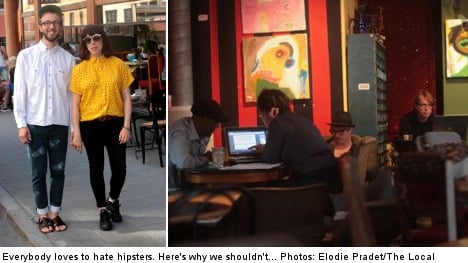With their origins in 1940s American bebop and nineties trans-Atlantic youth culture, hipsters have been around for a long time in some guise or another. They lie just under the surface, never quite shouting their presence but always there.
They’re also pretty easy to spot if you know what you’re looking for: a little wacky but not punk; a little grungy but they’re not stoners; a hipster has to maintain enough brain power to talk politics and know stuff about the world that you, my friend, simply don’t.
All in all, hipsters are a bit of a riddle. So let’s take a closer look at Sweden’s very own trendy lot shall we?
In Stockholm, you’ll find hipsters gravitate towards Sofo – South of the street Folkungagatan on Södermalm island – alongside quirky rockabilly cafes; graffiti clothed walls and retro shops. Hipsters are city kids; they need to be where’s it’s hip and where it’s hip is where they are.
Guys can be spotted wearing shirts done up to the chin and skinny jeans (either turned up or cropped above the ankle), sporting gentlemanly moustaches circa 1710 whilst riding bicycles. Stockholm’s hipsters also have a penchant for braces, tattoos and caps.
For girls, it’s often denim, brogues and hats in the style of sixties German singer, model and Warhol muse, Nico. A pretty frock does the job too, as does a floppy fringe. Trendy but nonchalant. Hipsters are the first to find a must-have item and wear it seasons before Joe and Fanny Average catch on.
Sofo hipsters have, at their disposal, numerous vintage, second-hand and retro stores. Just the right places to find a quirky little extra to make an American Apparel, Acne, or & Other Stories item stand out. Nitty gritty on Krukmakargatan, so I’m told, is one of the best hipster haunts, and one of the original.
IN PICTURES: Hipster hangouts in Sofo, and a couple of hipsters on the prowl
And while we’re talking of the nitty gritty, let’s get to the bottom of these so-called hipsters. There’s more to them than brogues and braces you know.
Hipsters, I will argue, serve an important cultural purpose. They have a knack of finding all the best places to hang out: the bars, the cafes, the parks. They remind us of our musical heritage with their fondness for nostalgia (lest we forget The Ramones or Johnny Cash) and inform us of new music with their non-conformist tastes (I don’t know any modern Hipster bands du jour so I can’t list any here).
And from a style perspective, they look… interesting.
Celebrity hipsters supermodel Agyness Deyn and actors Chloë Sevigny and Johnny Depp are a case in point. Whatever you think of Depp’s hobo-esque style, he is pretty darn cool isn’t he? And Sevigny, well she makes wearing socks and sandals look chic.
Hipsters normally only dip their toes in the fashion pool, only ever buying into brands that fit in with the hipster club mentality or sticking with no-one-else-is-wearing-it-so-I-will retro.
Whatever you think about hipsters, the group is thriving. There’s probably one not too far from you as you read this. But don’t be alarmed, they won’t bite. They’re just grown-up teenagers with a uni education and an Acne loyalty card.
So let’s for a moment show these kids some love. If only because really, deep down, we all want to be a little bit like them.
Victoria Hussey




 Please whitelist us to continue reading.
Please whitelist us to continue reading.
Member comments